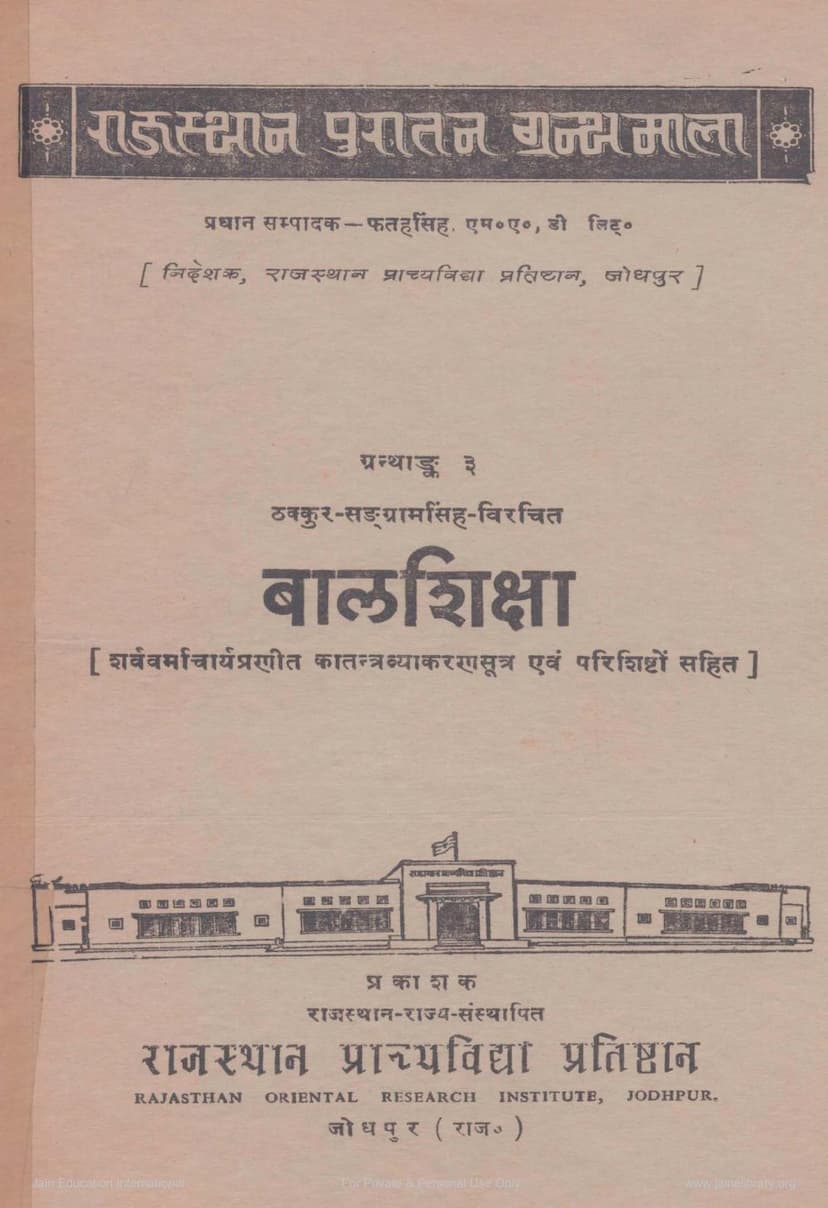Balshiksha
Added to library: September 1, 2025

Summary
The Jain text "Balshiksha" by Thakur Sangramsingh, published by Rajasthan Prachyavidya Pratishthan, Jodhpur, is a grammar primer based on the Katantra grammar of Sarvavarma. It was composed in the year 897 VS (Vikram Samvat), which corresponds to 840 CE.
Here's a comprehensive summary of the text, based on the provided pages and catalog link:
Overall Purpose and Context:
- "Balshiksha" (बालशिक्षा) translates to "Education for Children" or "Child's Instruction." Its primary purpose is to impart foundational grammatical knowledge to young learners.
- It is presented as a guide for understanding Sanskrit grammar, specifically following the principles laid down in the Katantra Vyakarana (कातन्त्रव्याकरण) by Acharya Sharvavarma.
- The text aims to make Sanskrit grammar accessible and understandable, even for those who might find the original Katantra text challenging.
Key Features and Content:
-
Foundation in Katantra Grammar: The book is structured around the Katantra grammar, which is known for its conciseness and systematic approach, particularly its focus on practical grammar for everyday use and for the era in which it was written.
-
Eight Chapters (Prakarana): The "Balshiksha" is organized into eight chapters, or "Prakarana" (प्रकरण), covering essential aspects of Sanskrit grammar:
- Sangya Prakarana (संज्ञाप्रकरण): Deals with grammatical terms and their definitions.
- Sandhi Prakarana (सन्धिप्रकरण): Covers the rules of phonetic assimilation (sandhi) in Sanskrit.
- Syadi Prakarana (स्यादिप्रकरण): Focuses on declensions (declining nouns, pronouns, and adjectives) and verb conjugations, including the various case endings ('syadi') and their applications. This is a very detailed section covering a vast array of word forms.
- Karaka Prakarana (कारकप्रकरण): Explains the grammatical cases (kāraka) and their usage in sentence construction.
- Samasa Prakarana (समासप्रकरण): Deals with Sanskrit compound words (samasa).
- Ukti Prakarana (उक्तिप्रकरण): Discusses different forms of speech or voice (active, passive, etc.) and verb conjugations.
- Sanskar Prakarana (संस्कारप्रकरण): This chapter is particularly noteworthy. It focuses on the "sanskar" ( संस्कार), meaning refinement or modification, of language. It includes a substantial list of words, many of which are in a vernacular or Prakrit form with their Sanskrit equivalents. This highlights the author's effort to bridge the gap between spoken languages and classical Sanskrit. The preface mentions a significant number of verbs listed here, which are current in various Prakrit and regional languages like Avadhi, Braj, Rajasthani, and Gujarati, indicating the text's linguistic significance in understanding language evolution in ancient India.
- Dhaturuap [Dhatu Rupa] Prakarana (धातुरूपप्रकरण): This section, presented in a list format, details verb roots (dhatu) and their various conjugations.
-
Linguistic Significance: The "Sanskar Prakarana" is highlighted as having particular importance from a linguistic perspective. The author's attempt to reconcile vernacular words and grammatical forms with Sanskrit, as seen in the listing of numerous verbs and their usage in contemporary languages, underscores its value in studying the history and development of Indian languages.
-
Author's Intent and Context:
- Thakur Sangramsingh, son of Koor Singh, aimed to create a foundational text for learning grammar.
- The preface by Fatah Singh, the editor/director of the Rajasthan Oriental Research Institute, praises the work and situates it within the tradition initiated by Hemachandra Acharya. It emphasizes the text's linguistic value in reflecting the contemporary language alongside Sanskrit grammar.
- The preface also addresses potential misinterpretations of the text's origins and emphasizes a pan-Indian cultural perspective, transcending religious and sectarian differences. It promotes unity in Indian thought and language.
-
Structure of the Edition: The publication includes the original text of "Balshiksha" along with the Sanskrit grammar sutras of Sharvavarma's Katantra, and additional appendices. These appendices are:
- List of "Balshiksha" Sutras.
- List of "Balshiksha" Verb Forms.
- List of "Balshiksha" Terminological Words.
- List of "Balshiksha" Language Words (referring to the vernacular words in the Sanskar Prakarana).
In essence, "Balshiksha" is a comprehensive, yet accessible, Sanskrit grammar primer from the Jain tradition, rooted in the Katantra system. Its unique contribution lies in its "Sanskar Prakarana," which sheds light on the relationship between classical Sanskrit and the vernacular languages of its time, making it a valuable resource for linguistic and historical studies.